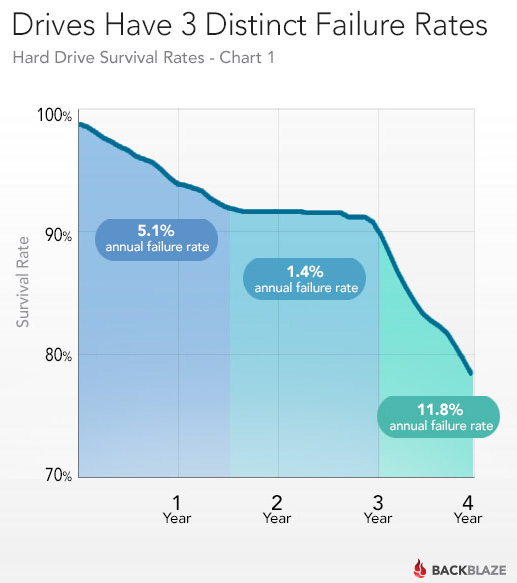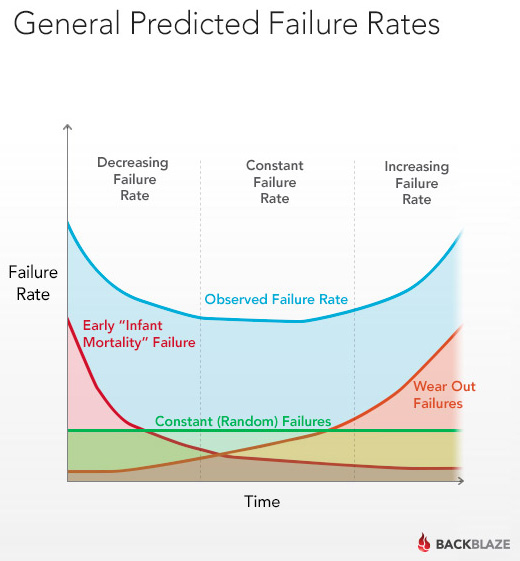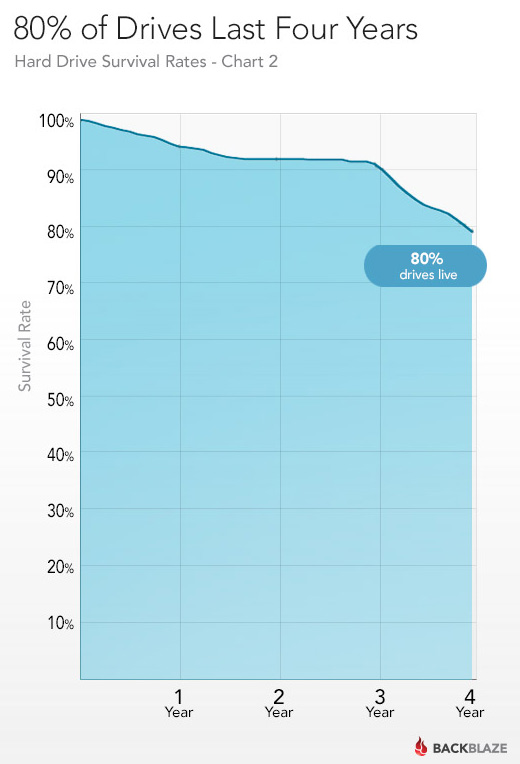
بیش از ۳۰ سال است که رشد و شکوفایی محاسبات با هارد دیسکها گره خورده است و این رابطه رابطهای پیچیده و گاه توام با رنج و عذاب بوده است. به هر حال به هیچ شکلی نمیتوان منکر نقش عمده هارد دیسکها در رشد و همه گیری پیسیها و اکنون در توسعه سریع فضاهای ذخیرهسازی آنلاین و کلاود شد. جالب اینکه به رغم این کاربرد گسترده هنوز سوالی اساسی وجود دارد که غالب ما جواب آن را نمیدانیم: یک هارد دیسک واقعا چقدر عمر میکند؟
واقعا به نظر شما یک هارد دیسک به صورت متوسط چقدر کار میکند؟ یک سال؟ سه سال؟ پنج سال؟ فقط به یاد داشته باشید که گارانتی غالب این محصولات تنها یک سال است!
البته به رغم استفاده گسترده از این تجهیزات (البته تا قبل از دنیای اسمارتفونها و حافظههای فلش) کسی تا کنون این موضوع را به صورت علمی و دقیق بررسی نکرده بود. اما اکنون Backblaze ، شرکتی که خدمات پشتیبانگیری آنلاین نامحدود ارایه میکند نتیجه مشاهداتش را در زمینه عمر هارد دیسکها منتشر کرده است. این شرکت برای ارایه خدماتش به صورت مداوم ۲۵ هزار هارد دیسک را روشن نگه میدارد و آنچه در ادامه مطالعه میکنید حاصل جمعبندی تجربههای این شرکت است.
عمر هارد دیسکها
Backblaze ۴ سال است که ۲۵ هزار هارد دیسک را دایما روشن نگه داشته است. هر زمان که یکی از آنها خراب شده است، بعد از تعویض مشخصات و مدت مان عملکرد هارد معیوب یادداشت شده است. اکنون شرکت دادههای جالبی درباره عمر هارد دیسکها (به خصوص در ۴ سال اول) دارد.

نخست اینکه به نظر میرسد هارد دیسکها در زمینه مشکلدار شدن سه مرحله زمانی مختلف را طی میکنند. در فاز اول که یک و نیم سال به طول میانجامد، حدود ۵.۱ درصد از هاردها به صورت سالانه دچار مشکل میشوند. در فاز دوم که آن هم یک و نیم سال به طول میانجامد نرخ خراب شدن سالانه به ۱٫۴ درصد کاهش مییابد. پس از این دوره سه ساله ناگهان نرخ خرابیها به ۱۱٫۸ درصد افزایش پیدا میکند. به صورت ساده ۹۲ درصد هارد دیسکها ۱۸ ماه اول را سپری میکنند و تقریبا همه آنها (۹۰ درصد تعداد اولیه) به عمر سه ساله خواهند رسید.
اما در نهایت از کل هارد دیسکهای اولیه تنها ۸۰ درصد میتوانند به ۴ سالگی برسند. شرکت Backblaze آماری برای سالهای بعدی در اختیار ندارد اما مهندسین خبرهاش تخمین میزنند که نرخ خرابی از سال چهارم به بعد روی ۱۲ درصد ثابت شود. در چنین صورتی میتوان گفت که تنها ۵۰ درصد هارد دیسکها به سن ۶ سالگی خواهند رسید.

چرا هارد دیسکها میمیرند؟
سه دوره زمانی برای خراب شدن هارددیسکها وجود داشت و به تبع سه دلیل اصلی نیز برای خراب شدن آنها در هر یک از دورهها وجود دارد. خرابی در سال اول معمولا نتیجه مشکلات [کارخانهای] موجود در ساخت هاردها است. در بازه ماه هجدهم تا سی وششم دلیل از بین رفتن هاردها، مشکلات تصادفی است که بیشتر بدشانسی مصرفکننده را نشان میدهند! از این به بعد و در دوره سوم مشکل اصلی که باعث خرابی هاردها میشود فرسودگی است. قطعات متحرک و دوار فرسوده شده و از کار میافتند.
نتیجه نهایی . . . بکآپ بگیرید
لازم به ذکر است که Backblaze از هارد دیسکهای معمول در بازار استفاده میکند که توسط کاربران معمولی نیز به کار برده می شود. البته در نظر داشته باشید که هاردهای این شرکت شبانه روز و ۷ روز هفته در حال کار هستند. به همین دلیل هارد دیسکهای شما احتمالا بسیار بیشتر عمر خواهد کرد. با در نظر گرفتن بازههای زمانی و دلیل خرابیها، اکنون دلیل تعیین زمان یک ساله برای گارانتی اکثر هاردها کاملا واضح است.

به هر حال اگر هارد دیسکی را امروز میخرید به احتمال ۹۰ درصد حداقل سه سال عمر خواهد کرد. اگر خوششانس بودید و هارد دیسکتان به این سن رسید بکآپ گرفتن را فراموش نکنید. چرا که نرخ خرابی ۱۲ درصد در سال هشداری برای شما محسوب خواهد شد. نکته مهمتر اینکه این آمار مربوط به هارد دیسکهای داخلی است. هاردهای به اصطلاح اکسترنال به دلایل مختلف ممکن است عمری به این بلندی نداشته باشند. البته اگر میزان استفاده شما از آنها کمتر باشد، مثلا هر از چند گاه آنها را روشن کرده و از سیستمتان بکآپ بگیرید به احتمال زیاد بیشتر عمر میکنند.
تجربه شما در استفاده از هارد دیسکها چیست و در کدام بازه زمانی خرابی قرار دارید؟
منبع : extremetech
How long do hard drives actually live for?
For more than 30 years, the realm of computing has been intrinsically linked to the humble hard drive. It has been a complex and sometimes torturous relationship, but there’s no denying the huge role that hard drives have played in the growth and popularization of PCs, and more recently in the rapid expansion of online and cloud storage. Given our exceedingly heavy reliance on hard drives, it’s very, very weird that one piece of vital information still eludes us: How long does a hard drive last?
Now, before you all rush to the comments section to tell me how long your hard drives have lasted, I’m not talking anecdotally. I mean, in hard numbers, just how long does the average hard drive last? One year? Three? Five? Because the standard warranty is now only 12 months, do hard drives die sooner? If I slot a new hard drive in today, how long can I expect it to last?
Surprisingly, despite hard drives underpinning almost every aspect of modern computing (until smartphones), no one has ever carried out a study on the longevity of hard drives — or at least, no one has ever published results from such a study. Until now. Backblaze, an unlimited online backup company that keeps 25,000 hard drives spinning at all time, has published its results on hard drive lifespan — and it makes for very interesting reading indeed.
How long does a hard drive last?
Backblaze has kept up to 25,000 hard drives constantly online for the last four years. Every time a drive fails, they note it down, then slot in a replacement. After four years, Backblaze now has some amazing data and graphs that detail the failure rate of hard drives over the first four years of their life.
Backblaze hard drive failure rate, over the first four years
Backblaze hard drive failure rate, over the first four years
It seems that hard drives have three distinct failure “phases.” In the first phase, which lasts 1.5 years, hard drives have an annual failure rate of 5.1%. For the next 1.5 years, the annual failure rate drops to 1.4%. After three years, the failure rate explodes to 11.8% per year. In short, this means that around 92% of drives survive the first 18 months, and almost all of those (90%) then go on to reach three years.
Extrapolating from these figures, just under 80% of all hard drives will survive to their fourth anniversary. Backblaze doesn’t have figures beyond that, but its distinguished engineer, Brian Beach, speculates that the failure rate will probably stick to around 12% per year. This means that 50% of hard drives will survive until their sixth birthday.
Hard drive failure matches the bathtub curve
Hard drive failure conforms to the bathtub curve — a curve that reliability engineers use that neatly illustrates the three distinct phases of a product’s lifecycle
Why hard drives die
There are three distinct failure phases — and, correspondingly, three distinct ways in which hard drives die. Failures in the first year are primarily caused by manufacturing defects. This describes the lemon effect — where, despite most of your drive live for years, some just die after a few months. Between 18 and 36 months, drive deaths are caused by random failures — small, random issues that only occur if you’re unlucky. Then, as the drive moves into its fourth year, failure rates skyrocket as drives start to wear out — the various components can only rotate, gyrate, and actuate so many times before something goes sprronngggg.
It’s worth noting that Backblaze uses normal, consumer-level drives — the kind of drives with 12- or 36-month warranties. Considering around 97.5% of these drives are still alive after one year, and about 90% are alive after three years, these warranties are probably spot-on.
Hard drive failure rate, by quarter, for the first four years
Hard drive failure rate, by quarter, for the first four years
In the case of enterprise-class hard drives with five-year warranties, they are probably manufactured to higher tolerances and subjected to more stringent quality assurance testing. We’re only guessing here, but enterprise-class drives probably don’t have the same year-one infant mortality rate, but still die off fairly quickly once their moving parts start to wear out (4+ years).
In conclusion… back up your data!
So, there you have it: If you buy a hard drive today, there’s a 90% chance that it will survive for three years. If your drive makes it to the three-year point, you would be wise to back up your data, as there’s a 12% chance per year that your drive will die. It’s worth noting that these figures are for internal hard drives: External hard drives, for a large number of factors, may not last as long (though if you only plug it in every few days to back your data up, it might last longer). It’s also worth mentioning that Backblaze’s drives are spinning constantly — these failure rates are for drives that are turned on 24/7. Your home computer probably isn’t powered up 24/7, and thus the drives may last longer.
Because there’s a 5.1% chance that your drive will die in its first year, you should either back up your data regularly — or, if you’re feeling dangerous, not keep any valuable data on that drive until it’s worked out any kinks and survived to the 18-month mark. After 36 months, though, you should definitely back up your data, or copy the data to a new hard drive. (Backblaze, at $5/month for unlimited backup space, is a remarkably good deal.)
Hard drive failure rate after four years: 80% are still alive
Backblaze says it will continue to update its data as the years go by, so that we can see if the failure rate indeed stays the same after the four-year mark. Of course, the other statistic we’re interested in is the failure rate of solid-state drives — but I imagine it’ll still be a few years until one company has enough SSDs to give us a good idea of the failure rate of NAND flash.
 گجت نیوز آخرین اخبار تکنولوژی، علم و خودرو
گجت نیوز آخرین اخبار تکنولوژی، علم و خودرو 





